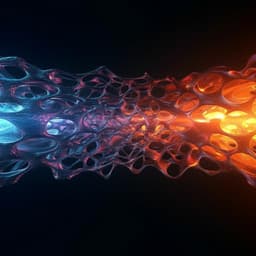Introduction
Second-harmonic generation (SHG), a nonlinear optical process, has wide applications in lasers, optoelectronics, and materials characterization. Integrated photonic platforms demand electrically tunable SHG for on-chip devices. While electric field-induced SHG (EFISH) has been explored in various materials, effective χ⁽²⁾ susceptibilities and modulation depths remain low. Tunable SHG in polar materials can be achieved by altering crystal structures or domain microstructures, but this often involves slow, hysteretic responses and fatigue. Topological polar structures like skyrmions offer new possibilities. These structures, observed in PbTiO3/SrTiO3 superlattices, have swirling electric dipoles and long-range ordering, leading to emergent properties including SHG circular dichroism. Their responsiveness to external stimuli suggests potential for SHG modulation. This research investigates the EFISH effect in polar skyrmions, aiming to demonstrate a high-performance, electrically tunable SHG mechanism.
Literature Review
Second-harmonic generation (SHG) has been extensively studied since its discovery in 1961, finding applications in various fields. Recent advancements in integrated photonics have fueled the demand for electrically tunable SHG for on-chip devices such as all-optical switches and quantum light sources. EFISH has been investigated in various materials, including crystals, polymers, silicon, and layered metal chalcogenides, but these often exhibit weak effective χ⁽²⁾ susceptibilities and low modulation depths. Alternative approaches using polar materials involve switching ferroelectric domains or inducing phase transitions, but these methods suffer from hysteresis and slow response times. The discovery of topological polar structures like vortices and skyrmions in PbTiO3/SrTiO3 superlattices provides new avenues for exploring tunable SHG. These structures exhibit unique properties such as negative permittivity and SHG circular dichroism, and their response to external stimuli suggests potential for high-performance EFISH.
Methodology
The study utilized [(PbTiO3)14/(SrTiO3)16]5 superlattices grown on (001)-cut (LaAlO3)0.3(SrAl0.5Ta0.5O3)0.7 (LSAT) substrates with a SrRuO3 buffer layer. LSAT was chosen for its low terahertz absorptivity and refractive index contrast with PbTiO3 and SrTiO3. Cross-sectional scanning transmission electron microscopy (STEM) and X-ray reciprocal space mapping (RSM) confirmed the high crystallinity and presence of polar skyrmions with a 7.6 nm in-plane periodicity. HAADF-STEM and differential phase contrast (DPC) imaging revealed the real-space skyrmion configuration, showing swirling polarization vectors and suppressed polarization magnitude near Néel-type domain walls. EFISH measurements were conducted on SrRuO3/superlattice/SrRuO3 capacitor devices with a 100 µm diameter. SHG intensity was measured as a function of bias voltage and light polarization angles. Synchrotron-based in situ RSM measurements and phase-field simulations provided insights into the microscopic mechanisms of the EFISH modulation. Temperature dependence, frequency response, and fatigue resistance of the EFISH effect were also investigated. A Fresnel-lens type device was proposed and simulated to illustrate the potential for SHG modulator applications.
Key Findings
The study demonstrated a giant EFISH effect in polar skyrmions, achieving a modulation depth of -664% V⁻¹ at 7 V and a second-order nonlinear susceptibility of -54.2 pm V⁻¹ . The EFISH response exhibited rich anisotropic behavior, with distinct patterns observed under different light polarization conditions. In situ RSM measurements revealed that the applied electric field induced a transition from the skyrmion state to a single c-domain state, with different transition paths observed for positive and negative biases. Phase-field simulations corroborated the experimental observations, showing skyrmion expansion/shrinkage and coalescence depending on the bias polarity. The EFISH effect was found to originate from a skyrmion wall-involved mechanism, where the applied field displaces the skyrmion walls, breaking the pseudo-centrosymmetry and activating the SHG response. The study further characterized the EFISH effect's temperature dependence, frequency response, and fatigue resistance. A high operating bandwidth (above 10 MHz), wide operating temperature range (up to ~400 K), and excellent fatigue resistance (>10¹⁰ cycles) were observed. A Fresnel lens device design was proposed and simulated, showing potential for enhancing the SHG signal and achieving electrically tunable focusing.
Discussion
The findings demonstrate that polar skyrmions in PbTiO3/SrTiO3 superlattices offer a highly competitive platform for electrically tunable SHG. The giant modulation depth, high χ⁽²⁾, and excellent device characteristics significantly advance the potential of EFISH devices for integrated photonics. The observed EFISH effect reflects the topological protection of skyrmions, suggesting a general strategy for manipulating the nonlinear optical properties of topological polar structures. The thin-film nature of the superlattices allows for further tuning of properties by adjusting misfit strain and layer makeup. Future research could explore other topological phases and optimize the design of devices to achieve even higher efficiencies.
Conclusion
This research demonstrated a giant electric field-induced second harmonic generation effect in polar skyrmions within PbTiO3/SrTiO3 superlattices. The combination of high modulation depth, strong nonlinear susceptibility, and excellent device characteristics positions this material as a highly promising candidate for advanced integrated photonic devices. Future work could explore other topological polar structures and investigate strategies for further enhancing the EFISH response.
Limitations
The large X-ray beam footprint used in the in situ RSM measurements introduced uncertainties in the quantitative analysis of the bias-induced behavior. The phase-field simulations, while providing valuable insights, do not fully capture the atomistic details of the SHG susceptibility. The proposed Fresnel lens device is a conceptual design and requires experimental validation.
Related Publications
Explore these studies to deepen your understanding of the subject.







